
Photography by Henry Leutwyler courtesy of Steidlville.

When Michael Jackson died last year, and clips of him dangling a baby over a balcony and dancing the moonwalk played in endless loops on cable television, what the media mourned was not a man but a hyper-celebrity, someone whose personal history touched upon every hot topic in American life: family dysfunction, race, fame, money, and sex. Beginning with bubble-gum pop music and ending in accusations of child molestation, his story became one of a heroic rise and a tragic downfall. What was omitted was a consideration of the man himself, whose friends described him as a gifted dancer and musician, and a thoughtful, if troubled, person.
A movie documenting rehearsals for Jackson’s planned world tour that hit theaters soon after his death,
This Is It, showcased his professionalism. The film revealed a breathtaking performer and an ambitious, intelligent, showman. He held himself to high standards and sought the same from those around him, directing his musicians, backup dancers, and technical crew with authority and tenderness.
In a similar vein photographer
Henry Leutwyler’s beautifully-designed book
Neverland Lost, which documents objects from Jackson’s estate, reveals some of the performer’s inner life.
(more…)
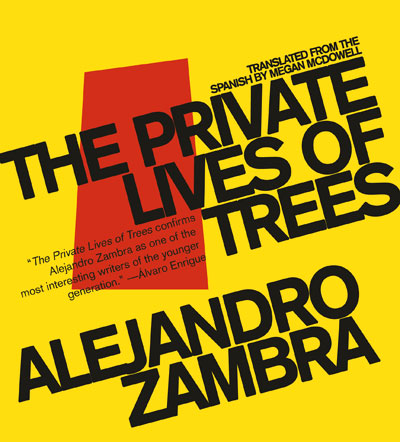
The Private Life of Trees. Cover courtesy of Melville House

Almost overnight, Alejandro Zambra has established himself as one of the leading emerging voices of Latin American fiction. His first novel,
Bonsai (2006, published in English by Melville House), was acknowledged as a unique and resonant piece, a peak in the diverse and chaotic panorama of contemporary fiction written in Spanish. Zambra’s sparse, quiet, almost austere novella, in which not much seemed to happen by means of plot or action, set a distinctive tone. Ian McEwan once described himself as the kind of novelist who could never fully master the art of the novel. One can never become an expert in writing novels, he said, you only resolve the enigma of narrative fiction one novel at a time. There is another kind of writer (e.g. Haruki Murakami) who does not set out to write novels in the sense described by McEwen: writers who build their books within a larger literary project. Murakami does not sit down to write novels: he sits down to write Murakami novels. Alejandro Zambra belongs in this second category. He has found a personal, idiosyncratic take on fiction, confirmed by his second novella
The Private Life of Trees (2007, Melville House).
Alejandro Zambra was an acclaimed poet before making the leap into fiction. This accounts for his uncanny ability for condensation, his radical minimalism, the restraint alluded to in the title of Bonsai. In the mid 1930’s, Borges devised the trick of summarizing non-existent works.
(more…)
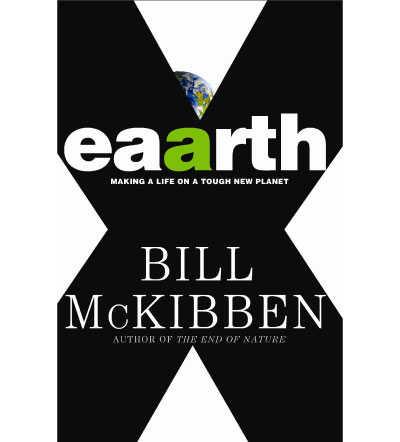
 Think of everything you know about global warming. Think, especially, of the sense you might have that there are twenty, thirty, fifty years left before the Earth’s levels of climate change become truly catastrophic. Now, think again. We’re already there, says Bill McKibben in Eaarth (Times Books, $24.00), an eloquent and passionate call to action. In fact, says McKibben, we’ve changed our planet so much that we can no longer think of it as Earth: now it’s Eaarth, a place of melting ice caps, expanding tropics, and increasingly dramatic “weather events”. And we have to learn to live there.
Think of everything you know about global warming. Think, especially, of the sense you might have that there are twenty, thirty, fifty years left before the Earth’s levels of climate change become truly catastrophic. Now, think again. We’re already there, says Bill McKibben in Eaarth (Times Books, $24.00), an eloquent and passionate call to action. In fact, says McKibben, we’ve changed our planet so much that we can no longer think of it as Earth: now it’s Eaarth, a place of melting ice caps, expanding tropics, and increasingly dramatic “weather events”. And we have to learn to live there.
McKibben should know what he’s talking about. A leading journalist and environmental activist, he’s been writing on this subject for more than twenty years. In 1989, his The End of Nature was the first book on global warming for a general audience. In the past two years, his nonprofit 350.org has mobilized millions of people across the world to combat climate change.
In Eaarth, he makes no bones about how serious the situation has become. We’ve already raised the temperature of the planet by one degree Celcius, he writes; as a result, the Arctic ice cap is 1.1 million square miles smaller, and (since warmer air holds more water vapor) global rainfall is increasing by 1.5 percent a decade. But this isn’t just a book full of dry statistics. McKibben is expert at explaining, lucidly and frankly, just what the numbers mean, and what we can do about them. “Forget the grandkids,” he writes. “It turns out this was a problem for our parents.”
(more…)
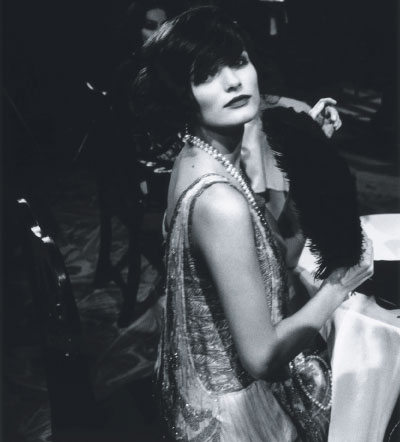
Photography courtesy of Steidl Books
 Despite its perennial reign at the pinnacle of French fashion, the storied house of Chanel has never shied away from venturing beyond its Gallic boundaries for inspiration. During Coco Chanel’s lifetime, her growing wealth and social status allowed her to flit around the globe, immersing herself in myriad aspects of foreign culture later to be distilled in future collections. Mademoiselle’s affinity for the Ballets Russe and the opulence of Byzantine jewelry resulted in a Russian influence that emerged in her designs. The historical link between Chanel and Russia provided the catalyst for Paris-Moscou, the house’s 2008 Métiers d’Arts collection which lies at the center of Karl Lagerfeld: Chanel’s Russian Connection, a book that was released last year by Steidl.
Despite its perennial reign at the pinnacle of French fashion, the storied house of Chanel has never shied away from venturing beyond its Gallic boundaries for inspiration. During Coco Chanel’s lifetime, her growing wealth and social status allowed her to flit around the globe, immersing herself in myriad aspects of foreign culture later to be distilled in future collections. Mademoiselle’s affinity for the Ballets Russe and the opulence of Byzantine jewelry resulted in a Russian influence that emerged in her designs. The historical link between Chanel and Russia provided the catalyst for Paris-Moscou, the house’s 2008 Métiers d’Arts collection which lies at the center of Karl Lagerfeld: Chanel’s Russian Connection, a book that was released last year by Steidl.
Conceived as a way to celebrate the specialized work of Chanel’s satellite ateliers, Métiers d’Arts collections are notably rich in detail. For Paris-Moscou, however, powerhouse head designer Karl Lagerfeld exceeded expectations, featuring a steady stream of Russian models, military-inspired menswear, glittering matryoshka doll appliqués, and towering jeweled headdresses.
(more…)


Photography courtesy of Gestalten Books (Click Images to Enlarge)

Steel freight containers have become favorite toys for ecocentric architects looking to repurpose existing materials. The crates themselves, which are eight-feet wide, eight or nine-feet high, and twenty or 40-feet long, are ideally proportioned building blocks. Their CORE-TEN steel frames and cladding make them incredibly strong, and resistant to corrosion and puncture. The units are manufactured with integral corner connectors so that they can be stacked vertically, strung horizontally, and stabilized diagonally with simple hardware. And both new and used containers are readily available. Because of the recent slow-down in international commerce, thousands of containers are lying unused at ports throughout the world.
Container Atlas: A Practical Guide to Container Architecture showcases some incredible buildings that have been assembled from these containers. The projects cover all styles, scales, and sensibilities, illustrating the broad range of effects that can be achieved.
Most designs leverage the rugged, industrial aesthetic of the containers, highlighting their corrugated cladding and leaving the scarred surfaces of used containers intact. A group of artists in Vancouver converted two used containers into an event space, where passers-by can stop to check out videos, artwork, or a live DJ. The graffiti-enhanced containers give the venue a gritty authenticity.
(more…)

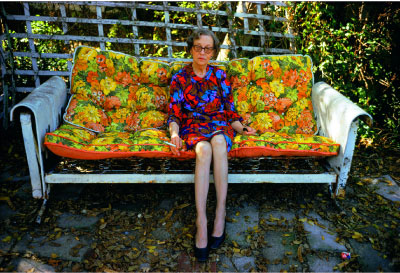
William Eggleston, Jackson, Mississippi, 1969-70 All photography courtesy of Hatje Cantz Publishers (Click images to Enlarge)


Color photography may have been invented as early as 1907, but the artistic viability of the medium was questioned even as recently as the 1980s. Henri Cartier-Bresson, who is currently the subject of
a retrospective at MoMA, was a particularly notable opponent.
Starburst: Color Photography in America 1970-1980, released this spring by Hatje Cantz publishers, explores the work and ramifications of the artists whose breakthrough images opened the floodgates for color photography’s later practitioners. Beginning with William Eggleston’s watershed show at MoMA in 1976, the book takes readers through the early work and critiques of contemporaries Stephen Shore, Helen Levitt, Joel Meyerowitz, William Christenberry, Jan Groover, Barbara Kasten, Richard Misrach, Joel Sternfeld, Eve Sonneman, and many more. Accompanied by contemporary critical essays as well as many original reviews, this survey provides a snapshot of a powerful and surprisingly recent paradigm shift in the course of modern photography.
(more…)
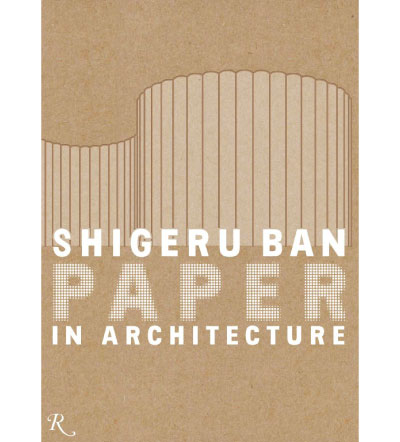
All images courtesy of Rizzoli, from Shigeru Ban: Paper in Architecture

There are great architects who work with established conventions, elevating them masterfully. And there are great architects who work without regard to conventions, establishing their own way of building. Shigeru Ban is this kind of architect. His innovative structures employ industrial cardboard tubes as structural framing elements. Collected in last year’s book Shigeru Ban: Paper in Architecture, these projects seem especially meaningful right now, as we rebuild after earthquakes in Haiti and Chile and search for an architecture that’s practical, inexpensive, and beautiful.
Like Frank Gehry houses of exposed wood studs and plywood, and Tadao Ando’s buildings in poured concrete, Ban’s structures take an everyday building material and transform it with ingenuity and grace. Ban has studied these tubes for decades, working closely with engineers and lawmakers in Japan to establish standard construction methods, details, and metrics. He single-handedly advanced their technology and developed their vocabulary, one that’s on the verge of a new kind of architecture.
(more…)
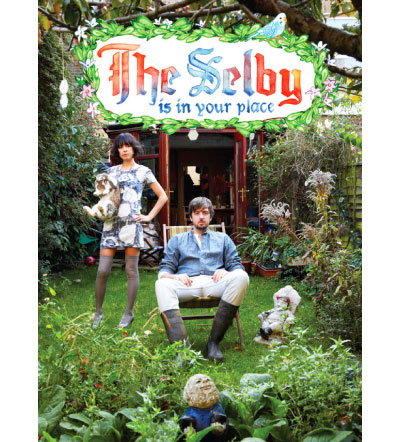
All photographs © Todd Selby, from The Selby is In Your Place by Abrams.

TheSelby.com has been a must-visit since its launch in 2008. Followers the world over click on regularly to see which artists, designers, performers, and style-makers have been most recently anointed, pictured in their living and working spaces by New York based photographer Todd Selby. Now Selby has compiled some of his best photo essays, along with the watercolor illustrations and hand-written questionnaires that accompany them, in one volume, The Selby is In Your Place.
Since the website’s launch he’s been inundated by requests from viewers to visit them and photograph their homes. In an email conversation, Selby explained that he typically finds new subjects through recommendations from friends. In addition, he does extensive research before visiting artists’ homes to ensure that their decorative sensibility will suit his own, which clearly tends toward excess. As he states: “Minimalism is boring. Maximalism is exciting.”
Selby’s photographs have tapped into a brand of interior design that has long been associated with artistic and bohemian living, one in which the home becomes a backdrop for a dense, eccentric, artfully curated display of personal possessions. Selby himself grew up in the suburbs of Orange County, California. ”Our house had tons of funny stuff we had collected from our travels,” he remembers. Similarly, the interiors that he’s drawn to are encrusted with their owners’ things: found objects, momentos, talismans, artwork, and antiques. They’re at once immensely stylish and intensely personal.
(more…)

Published by Laurence King.

Here’s a book from last year that slipped under our radar: Extreme Architecture: Building for Challenging Environments, by Ruth Slavid. It’s a compilation of contemporary structures that were designed in response to extraordinary environmental conditions (heat, cold, water, altitude, and outer space) and less directly in response to aesthetics.
Some of the projects, such as a ski jump by Zaha Hadid and a spa by Mario Botta, are self-consciously avant-garde and others, such as snow sheds and desert schools, are fundamentally utilitarian. Yet all, as they turn to meet the challenges of the environment, unsettle expectations of what a building should look like. They don’t simply fall into fashion.
Rather than sit upright on the ground, as conventional buildings do, those in hot and windswept climates tend to burrow beneath it, and those in wet and high climates tend to leap away from it. The buildings are similarly polarized in appearance, evoking either prehistoric or futuristic styles. A hotel in Patagonia, finished in roughly hewn wood and sunk into the earth, resembles a neolithic ruin. A giant drum-shaped workstation in Antarctica, hovering on squat steel legs, looks like a science fiction stage set. Many of the structures have an animated quality, as if they’re creatures who’ve undergone evolutionary mutations and adaptations. A cultural center in British Columbia, Canada lies camouflaged within the scrubby landscape. A ski jump in the Alps lifts its head above adjacent peaks like a brontosaurus.
(more…)
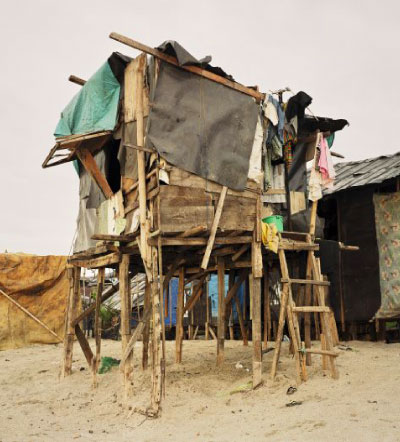
All Photography by Peter Bialobrzeski, courtesy of Hatje Cantz.

Peter Bialobrzeski’s photographs of houses in the informal community of Baseco, Manila, might be especially relevant right now. The small, tilting, wood-framed homes in these pictures, sealed with scraps of fabric, plastic tarps, and posters, are vivid expressions of vulnerability and determination. They remind one of the emergency conditions in Haiti, where thousands of people are currently living in similarly constructed makeshift shelters and, because of cyclical poverty and challenges in rebuilding, could remain indefinitely.
The collection’s title, “Case Study Homes”, refers ironically to the Los Angeles Case Study Houses of the 1950s, a series of modernist prototypes documented in coolly glamorous photographs by Julius Schulman. Bialobrzeski’s photographs don’t have that gloss, of course, but they possess a stately formal beauty that confers dignity on the houses. A diffuse tropical light mutes vivid colors and shadows to give the images a silvery, etched appearance, like Walker Evans’ Depression-era photos. While Evans looked straight into his subject’s faces, however, Bialobrzeski only examines the outside of their homes, a strategy that steers clear of sentimentality. These photographs give straightforward testimony.
(more…)





 Facebook
Facebook Permalink
Permalink Digg
Digg Reddit
Reddit LinkedIn
LinkedIn StumbleUpon
StumbleUpon Tumblr
Tumblr













